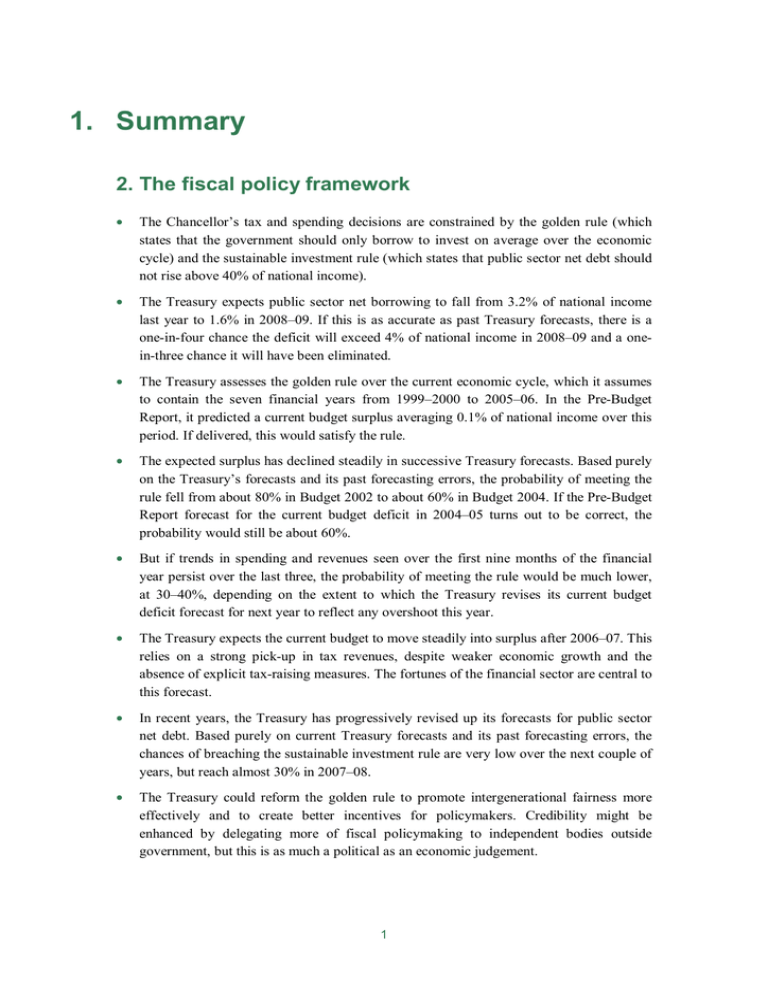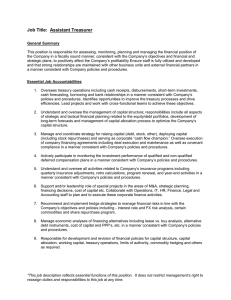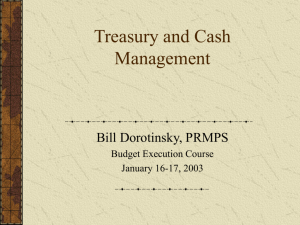1. Summary 2. The fiscal policy framework
advertisement

1. Summary 2. The fiscal policy framework • The Chancellor’s tax and spending decisions are constrained by the golden rule (which states that the government should only borrow to invest on average over the economic cycle) and the sustainable investment rule (which states that public sector net debt should not rise above 40% of national income). • The Treasury expects public sector net borrowing to fall from 3.2% of national income last year to 1.6% in 2008–09. If this is as accurate as past Treasury forecasts, there is a one-in-four chance the deficit will exceed 4% of national income in 2008–09 and a onein-three chance it will have been eliminated. • The Treasury assesses the golden rule over the current economic cycle, which it assumes to contain the seven financial years from 1999–2000 to 2005–06. In the Pre-Budget Report, it predicted a current budget surplus averaging 0.1% of national income over this period. If delivered, this would satisfy the rule. • The expected surplus has declined steadily in successive Treasury forecasts. Based purely on the Treasury’s forecasts and its past forecasting errors, the probability of meeting the rule fell from about 80% in Budget 2002 to about 60% in Budget 2004. If the Pre-Budget Report forecast for the current budget deficit in 2004–05 turns out to be correct, the probability would still be about 60%. • But if trends in spending and revenues seen over the first nine months of the financial year persist over the last three, the probability of meeting the rule would be much lower, at 30–40%, depending on the extent to which the Treasury revises its current budget deficit forecast for next year to reflect any overshoot this year. • The Treasury expects the current budget to move steadily into surplus after 2006–07. This relies on a strong pick-up in tax revenues, despite weaker economic growth and the absence of explicit tax-raising measures. The fortunes of the financial sector are central to this forecast. • In recent years, the Treasury has progressively revised up its forecasts for public sector net debt. Based purely on current Treasury forecasts and its past forecasting errors, the chances of breaching the sustainable investment rule are very low over the next couple of years, but reach almost 30% in 2007–08. • The Treasury could reform the golden rule to promote intergenerational fairness more effectively and to create better incentives for policymakers. Credibility might be enhanced by delegating more of fiscal policymaking to independent bodies outside government, but this is as much a political as an economic judgement. 1 Green Budget, January 2005 3. The economic outlook • The UK economy has been unusually stable in recent years, with growth less variable, and inflation lower and less volatile, than in previous decades. But there is no strong evidence that economic stability and government policies have raised the sustainable long-term growth rate of the economy and living standards. • The Treasury believes that the sustainable ‘trend’ growth rate of the economy is 2¾% a year, falling to 2½% in 2007. This looks plausible. The Treasury uses a deliberately cautious growth estimate – a quarter of a point lower – to project the public finances. But caution would be better incorporated in other ways. • The Treasury estimates that economic activity was around 1% below the level consistent with stable inflation in the third quarter of 2004. But statistical filtering of output data and analysis of the use of capital and labour in production suggest that there is little or no spare capacity in the economy. • The Treasury forecasts relatively strong above-trend economic growth over the next two years. We think growth will be somewhat weaker than the Treasury expects over this period, but its longer-term projections look plausible. There is the risk of a more dramatic slowdown if a steep downturn in the housing market hits consumer spending or if global conditions weaken the UK’s export markets. 4. Public finance forecasts • The current budget deficit is likely to be more than £3 billion bigger this year and £6 billion bigger next year than the Treasury predicted in December’s Pre-Budget Report, according to the Green Budget baseline forecast. This reflects stronger-than-forecast spending and weaker-than-expected revenues. • On these figures, the government would narrowly break its golden rule over the current economic cycle, if the cycle ends in 2005–06 as the Treasury expects. But if there is less spare capacity in the economy than the Treasury thinks, and the cycle is already in its final year, the rule should be met narrowly. • The current budget balance will remain in deficit on the Green Budget baseline forecast, rather than moving into surplus in 2006–07 as the Pre-Budget Report predicted. By 2009– 10, the Green Budget forecast for the current budget balance is over £15 billion more pessimistic than the Treasury’s. • The Treasury expects government revenues to rise by 2.2% of national income over the next five years, 1% of national income more than can be explained by the typical impact of the economic cycle and fiscal drag. The Green Budget baseline forecast shows revenues rising by 1.6% of national income. • Higher borrowing than the Treasury expects translates into a faster build-up of public sector net debt. The Green Budget baseline forecast suggests that, on the basis of past forecasting performance, there is a 50-50 chance of public sector net debt breaching the 40% of national income limit laid down by the sustainable investment rule, in 2008–09. 2 Summary • Morgan Stanley predicts somewhat weaker economic growth than the Treasury in the near term. This would result in slightly higher borrowing and see the net debt ratio breach 40% in 2008–09. If consumer spending is significantly depressed – for example, by a sharp downturn in the housing market – borrowing could be much higher and the debt ratio is likely to exceed 50% by 2009–10. • It is impossible be sure whether tax-raising measures will be needed to meet the fiscal rules over the next economic cycle, as we do not know how long that cycle will be. But to put the public finances back on a path as strong as the Treasury aimed for in the 2004 Budget would require a tax increase of at least £11 billion. 5. Funding issues and debt management • Much more government debt is likely to be issued over the next five years than over the last five. But demand from insurance and pension funds should be strong, while issuance by the UK is likely to remain well below that of the largest Euro area countries. So this is unlikely to require a significant rise in bond yields. • The Debt Management Office has pursued a simple, predictable and transparent funding strategy, issuing debt across the maturity spectrum to achieve a relatively smooth redemption profile. Targeting debt issuance better on the needs of life insurance companies and pension funds might save the government money. • There is a strong argument for the government to issue more long-dated and index-linked debt. The relative shortage of this sort of debt may be keeping long rates unusually low. But the Debt Management Office is now planning to issue ultra-long 50-year gilts. • The government might also find it attractive to provide greater liquidity to the options market, to encourage the issuance of bonds linked to life expectancy and to make Private Finance Initiative and mortgage-backed bonds more attractive to institutional investors. This could help both borrowers and the wider economy. 6. The tax burden under Labour • By next year, Labour will be taking 2.1% more of national income in tax and other receipts than the Conservatives did in 1996–97. It expects to take a further 1.3% of national income by 2009–10, increasing government revenues to 40.5% of national income. This is the highest since the mid-1980s, but still lower than the average during the Conservatives’ four terms in government from 1979 to 1997. • About a third of the £26 billion a year increase in government revenues expected by the end of Labour’s first two terms reflects policy announcements by Gordon Brown. Another third reflects Conservative decisions he has chosen not to fully reverse. The economic cycle and fiscal drag contributed £23.3 billion, offset by other factors that cost £14.9 billion, such as falling profits of financial companies. • The Treasury expects tax revenues to grow more quickly over the next five years than they have under Labour to date, despite weaker economic growth and the absence of 3 Green Budget, January 2005 explicit tax-raising measures. ‘National income after tax’ is forecast to grow more slowly over the next five years than at any time since the early 1980s. • The last six pre-election Budgets have cut taxes. Labour increased taxes shortly after the 1997 election, cut them in the run-up to the 2001 election and increased them again in the subsequent Budget. This suggests that if the Chancellor believes that new tax increases are necessary, he may wait until after polling day to announce them. 7. The distributional effects of tax and benefit reforms since 1997 • Tax and benefit changes under Labour to date will have a net cost to the exchequer of around £1.1 billion in 2005–06. This is the difference between a large set of changes raising around £57.2 billion and a slightly larger set of changes costing £58.3 billion. • Tax and benefit reforms implemented in Labour’s first term cost a net £4.8 billion, while those since 2001 have raised a net £3.7 billion. • The average impact of the £1.1 billion tax and benefit giveaway since 1997 is to raise household disposable incomes by £0.84 a week or 0.2%. The biggest proportionate gains are in the second-poorest tenth of the population, whose disposable incomes are increased by 10.1%, while the richest tenth fare worst, with a cut in income of 5.8%. • Tax and benefit reforms since 1997 have clearly been progressive, benefiting the lesswell-off relative to the better-off. Reforms in the second term – while less generous on average – were more progressive than those in the first, with the poorest faring better. • Increases in council tax above inflation since 1997 will raise a net • £5.8 billion for local government in 2005–06, net of council tax benefit. This outweighs the £0.84 a week net giveaway per household by central government and leaves households overall £3.62 a week worse off on average. • The increase in council tax is regressive, except for the poorest fifth of the population (thanks to council tax benefit). But the impact of council tax on the relative distribution of income is modest, leaving the overall progressive pattern of tax and benefit changes since 1997 intact. 8. Issues in business taxation • Corporation tax revenues have come in below expectations in recent years, but the Treasury is still confident that they will rebound strongly over the next few years. Recent trends may reflect the difficulties of the financial sector, but corporation tax revenues are also under long-term pressure from international tax competition and anti-discrimination decisions by the European Court of Justice. • Corporation tax rates in the UK are low relative to those in other G7 and European countries, but the gap is narrower than it used to be. The accession of 10 new members to 4 Summary the European Union, most of which have very low corporate tax rates, may intensify downward pressure on tax rates in the older EU countries. • Most national corporate tax systems discriminate against transactions with foreign countries. In recent years, multinational companies have been more successful in challenging such discrimination at the European Court of Justice. The UK has tended to respond by making the tax system less generous to domestic companies, but that may be difficult if ‘group relief’ is outlawed. • The government’s attempt to help small companies through a zero corporation tax rate prompted a rush by unincorporated businesses to change their legal status, reducing income tax revenue. The government says it wants businesses to determine their legal status for commercial rather than tax reasons, but this is difficult to achieve as long as labour and capital income are taxed differently. 9. Reforms to childcare policy • The government launched its 10-year childcare strategy in December. The government intervenes in the market for childcare to improve children’s prospects and make it easier for parents to work. If achieved, these goals can promote both equity and economic efficiency. • The childcare tax credit offers some working parents a subsidy to help pay for formal childcare. The cost and number of beneficiaries have risen sharply under Labour. Criticisms of the childcare tax credit include complexity, inadequate targeting on poor families and a lack of incentives to improve childcare quality. • The government might have more influence on childcare quality if it diverted money from the credit to subsidies for providers. Money could also be recycled within the tax credit system better to encourage work or help families with children, without trying to influence choice between formal and informal childcare. • The 10-year childcare strategy includes the eventual goal of offering free nursery education to all 3- and 4-year-olds for 20 hours a week for 38 weeks a year. This could double the annual cost of free nursery provision from approximately £1.3 billion today to £2.6 billion, excluding the cost of necessary extra physical infrastructure. • If the government wants to give all children equal access to high-quality childcare, expanding free provision may not be the most cost-effective way to do so. The expansion could be targeted on the most deprived areas or access could be means-tested. But this might have other drawbacks. 5






